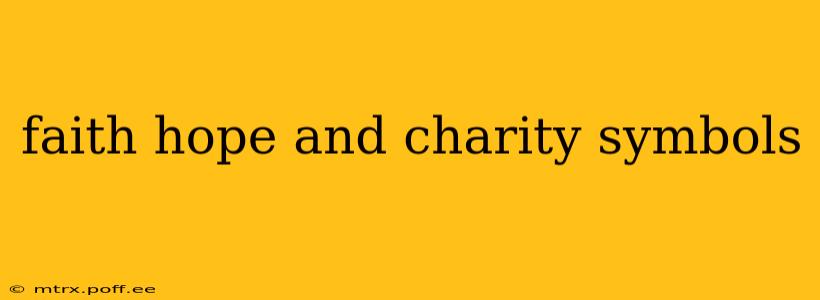Faith, hope, and charity—these three theological virtues form the cornerstone of Christian theology, representing essential spiritual qualities for believers. Understanding their symbolic representations deepens our appreciation for their significance and impact on spiritual life. This exploration delves into the rich symbolism associated with each virtue, providing insights into their meaning and representation across different contexts.
What are the Symbols of Faith?
Faith, the unwavering belief in God and His promises, is often visually represented through symbols that convey trust, steadfastness, and unwavering conviction. While there isn't one single definitive symbol, several powerful images consistently represent faith:
-
The Anchor: This potent symbol signifies stability and steadfastness in the face of life's storms. The anchor firmly holds a ship, much like faith anchors the soul amidst life's challenges and uncertainties.
-
The Cross: The most prominent symbol of Christianity, the cross represents the ultimate sacrifice made by Jesus Christ and the unwavering faith demonstrated through His suffering and resurrection. It symbolizes faith's power to overcome suffering and death.
-
The Dove: In Christian tradition, the dove symbolizes the Holy Spirit, representing the divine guidance and inspiration essential for maintaining strong faith. The dove's gentle nature also reflects the peace that comes with profound faith.
-
The Burning Bush: This biblical symbol, from the Book of Exodus, represents God's presence and the unwavering faith of Moses in the face of the divine. The bush burning yet unconsumed signifies enduring faith amidst trials.
What are the Symbols of Hope?
Hope, the confident expectation of future good, often manifests visually through symbols of promise, renewal, and the anticipation of a brighter tomorrow. The symbolism of hope is deeply intertwined with the concept of resurrection and new beginnings:
-
The Rising Sun: This potent image symbolizes the dawn of a new day, a fresh start, and the promise of a brighter future—mirroring the hope for redemption and salvation.
-
The Green Plant or Sprout: This symbol represents growth, renewal, and the potential for life to flourish even in challenging circumstances, embodying the resilient nature of hope.
-
The Rainbow: In biblical context, the rainbow symbolizes God's covenant with humanity, promising a future free from catastrophic destruction. It's a visual reminder of divine promise and hope for a better world.
-
The Lily: Often associated with purity and innocence, the lily also symbolizes hope, particularly in the context of resurrection and eternal life.
What are the Symbols of Charity?
Charity, often interpreted as love, encompassing compassion, kindness, and selfless giving, is visually depicted through symbols that represent selfless service, compassion, and unconditional love:
-
The Heart: The universally recognized symbol of love, the heart represents the core of charity – a selfless, compassionate love for others.
-
The Open Hands: Open hands symbolize giving, sharing, and offering assistance to others. It embodies the active nature of charity, demonstrating love through action.
-
The Good Shepherd: This biblical image represents God's unwavering love and care for His people, mirroring the compassionate nature of charity and the protection it offers.
-
The Samaritan: The parable of the Good Samaritan illustrates the importance of extending compassion and help to others regardless of their background or status, showcasing the true essence of charity.
What is the significance of Faith, Hope, and Charity?
The significance of faith, hope, and charity lies in their interconnectedness and their role in shaping a virtuous and fulfilling life. They are not isolated qualities but rather interdependent virtues that support and strengthen one another. Faith provides the foundation, hope offers the motivation, and charity inspires the action. Together, they guide individuals toward a life of spiritual growth and service to others.
How are Faith, Hope, and Charity related to each other?
Faith, hope, and charity are inextricably linked. Faith fuels hope, providing a foundation for believing in a better future. Hope motivates action, inspiring us to strive towards that better future. And charity, driven by both faith and hope, is the tangible expression of love and service to others. This synergistic relationship underscores the importance of cultivating all three virtues for a holistic spiritual life.
Are Faith, Hope, and Charity the same as Cardinal Virtues?
No, faith, hope, and charity are distinct from the cardinal virtues (prudence, justice, fortitude, and temperance). Cardinal virtues are natural human virtues that guide moral behavior, while faith, hope, and charity are theological virtues, infused by God's grace, focusing on our relationship with the divine. Both sets of virtues are crucial for a virtuous life, but they operate on different levels and address different aspects of human existence.
This exploration aims to provide a deeper understanding of the symbolism associated with faith, hope, and charity. The visual representations of these theological virtues serve as powerful reminders of their significance in shaping our spiritual journey and interactions with the world. They invite us to reflect on the importance of these virtues in our own lives and to strive toward embodying them fully.
